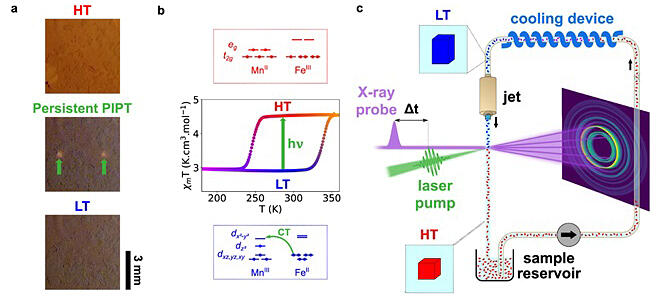A joint research team led by Professor Shin-ichi Ohkoshi of the School of Science at the University of Tokyo, Professor Hiroko Tokoro of the Institute of Pure and Applied Sciences at the University of Tsukuba, and Professor Eric Collet at Universite de Rennes, France, announced on January 22 that they have developed a new measurement method called "sample flow ultrafast time-resolved X-ray diffraction" to monitor changes in crystal structure by high-speed X-ray diffraction. In this method, when a substance undergoing phase transition under light irradiation is observed by X-ray diffraction, the sample is initialized by pouring and cooling a liquid in which the substance is dispersed, which is followed by re-irradiation with light.

Provided by the University of Tokyo
The optical phase transition in photonic memory materials at room temperature is irreversible. Since this transition is triggered by a single burst of laser light, it cannot be measured cumulatively, which makes it difficult to observe the phase transition over time. Keeping track of the structural changes of optical memory materials was considered difficult. The newly developed "sample flow ultrafast time-resolved X-ray diffraction" enables monitoring of crystal changes in optical memory materials with an ultrafast time resolution of 35 ps.
Optical phase transition is a phenomenon in which two states are switched by light. It is an important phenomenon that serves as the operating principle for photonic devices, memories, actuators, and other light-driven devices. From a practical viewpoint, it is important that the optical phase transition occurs at room temperature and that the temperature range over which the two states can be switched is wide. In other words, the temperature hysteresis of the phase transition material should be wide.
To demonstrate the new method, the research team synthesized a new material (a rubidium-manganese-cobalt-iron Prussian blue compound) and measured the photoinduced phase transition phenomena at room temperature. They utilized the beamline at the European Synchrotron Radiation Facility (ESRF) to observe the changes in crystal structure during the optical phase transition of the rubidium-manganese-cobalt-iron Prussian blue compound using the developed method.
The material undergoes a charge-transfer type phase transition, transitioning from a charge state of MnII-NC-FeIII at high temperatures (HT phase) to a charge state of MnIII-NC-FeII (LT phase) upon cooling. The phase transition from the HT phase to the LT phase by cooling occurred at -20° C (253 K). Conversely, the phase transition from the LT phase to the HT phase by heating occurred at 55° C (328 K).
At room temperature, the temperature range of the temperature hysteresis was as large as 75 K. With laser irradiation, this material undergoes a phase transition from the LT phase to the HT phase at room temperature. The HT phase is generated by a color change at the point where the laser light is irradiated. The research team expects that the new method will aid in studying the time dynamics of irreversible phenomena, such as optical write/erase.
In 2022, Centre national de la recherche scientifique (CNRS), the University of Tokyo, and Universite de Rennes established DYNACOM as an international institute to study the rapid time dynamics of optical phase transitions, in collaboration with the ESRF and other organizations. Ohkoshi is the director of the institute, Collet is the deputy director, and Tokoro is a faculty member at this institute.
Journal Information
Publication: Nature Communications
Title: Ultrafast and persistent photoinduced phase transition at room temperature monitored by streaming powder diffraction
DOI: 10.1038/s41467-023-44440-3
This article has been translated by JST with permission from The Science News Ltd. (https://sci-news.co.jp/). Unauthorized reproduction of the article and photographs is prohibited.




